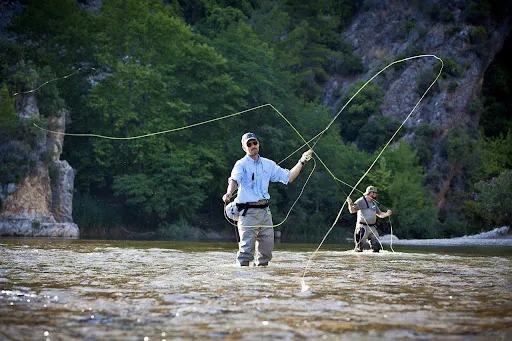5 minute read
Fly fishing is more than just a sport; it’s an experience that connects you with nature, tests your patience, and rewards you with moments of peace and accomplishment. If you’ve ever been curious about casting a line in flowing rivers or serene lakes, this guide is for you. Starting fly fishing as a beginner can feel overwhelming, with its unique techniques, specialized gear, and vast knowledge of fish and water.
But don’t worry – you don’t have to master everything overnight. This post will walk you through the basics, from selecting the right equipment to understanding casting techniques and reading the water. With these foundational tips, you’ll be well on your way to enjoying fly fishing as a relaxing and fulfilling outdoor pursuit.
Get Guidance from Experts to Learn Techniques and Local Tips
Learning from experienced anglers can fast-track your fly fishing progress. Experts know the best spots, seasonal patterns, and techniques that beginners may overlook. Consider joining a local fly fishing club, where you can ask questions, observe techniques, and receive guidance on gear.
Some seasoned anglers also offer classes or guided fishing tours, allowing you to learn firsthand. For instance, you can study Pyramid Lake Nevada boat fly fishing guides to understand effective strategies specific to local waters. By connecting with professionals, you’ll gain insights into the nuances of fly fishing, building skills and confidence more quickly.
Choose the Right Gear
One of the first steps in learning to fly fish is choosing gear that suits beginners. While fly fishing equipment can range widely in price and quality, beginners should focus on simplicity and functionality.
Start with a medium-action rod that’s easy to control and responsive enough for various conditions. A standard 9-foot rod in the 5-6 weight range is versatile, accommodating both small streams and larger bodies of water. Pair it with a reel suited to the rod’s weight and a basic fly line.
Investing in these essentials helps you understand the fundamentals of casting and control. Quality gear doesn’t have to be expensive, so look for reputable brands with good beginner options.
Learn Basic Casting Techniques for Accuracy and Control
Mastering a few basic casting techniques will set a solid foundation for your fly fishing journey. Unlike conventional fishing, fly fishing requires a unique style of casting where the weight of the line propels the lure. Begin by learning the basic overhead cast and roll cast, focusing on timing, fluid movements, and control over the line’s speed and direction.
Practice these techniques regularly, even in your backyard, to develop muscle memory. Start with short casts and work up to longer ones as you gain confidence. Accuracy is key, especially in smaller waters or streams. With time and practice, your casting will improve, enhancing your overall fishing experience.
Study Fish Behavior and Water Patterns to Increase Success
Understanding fish behavior and water patterns can make a huge difference in fly fishing. Fish are sensitive to light, temperature, and water currents, so knowing when and where they’re likely to gather can improve your chances. For instance, early mornings or evenings tend to be more productive as fish are more active. Study the surface of the water; calm sections may indicate resting areas, while faster currents can lead to feeding zones.
Additionally, water temperature plays a role in determining fish movement and feeding habits. By observing your surroundings, you’ll start to anticipate where fish are, helping you cast in the right places with more success.
Understand the Importance of Choosing the Right Flies
Selecting the right flies is crucial in fly fishing, as it determines how likely fish are to take the bait. Flies come in various types, including dry flies, nymphs, and streamers, each representing different insects or baitfish in the water. For beginners, starting with a basic selection of flies matching common insect species in your area is ideal.
Research the seasonal hatches in your fishing location to understand what’s likely to attract fish. Additionally, be aware of the fly size and color; a well-chosen fly will mimic the fish’s natural prey, making it more enticing. Proper fly selection is essential, so invest time in learning what works best in specific waters.
Practice Patience and Enjoy the Process of Learning
Fly fishing is an art that requires patience, practice, and persistence. Don’t expect to master every technique or catch fish right away – the journey is as fulfilling as the result. Take time to appreciate the environment, the peacefulness of the water, and the thrill of each cast. Regular practice, even in short sessions, will gradually improve your skills, from casting accuracy to reading water conditions.
Embrace the mistakes as learning moments, and remember that every angler, no matter how experienced, was once a beginner. Fly fishing offers a unique connection with nature, so take it slow and enjoy each step of the process.
Starting your fly fishing journey is both exciting and rewarding, especially as you build confidence with each cast and start to see success. By focusing on the basics – from selecting the right gear and learning casting techniques to studying fish behavior and getting guidance from experts – you’ll develop essential skills that enhance every fishing trip. Remember, patience and practice are your best companions on this journey. Fly fishing isn’t just about the catch; it’s about immersing yourself in nature, refining your skills, and enjoying the process. With dedication, you’ll soon experience the unique fulfillment fly fishing offers.





